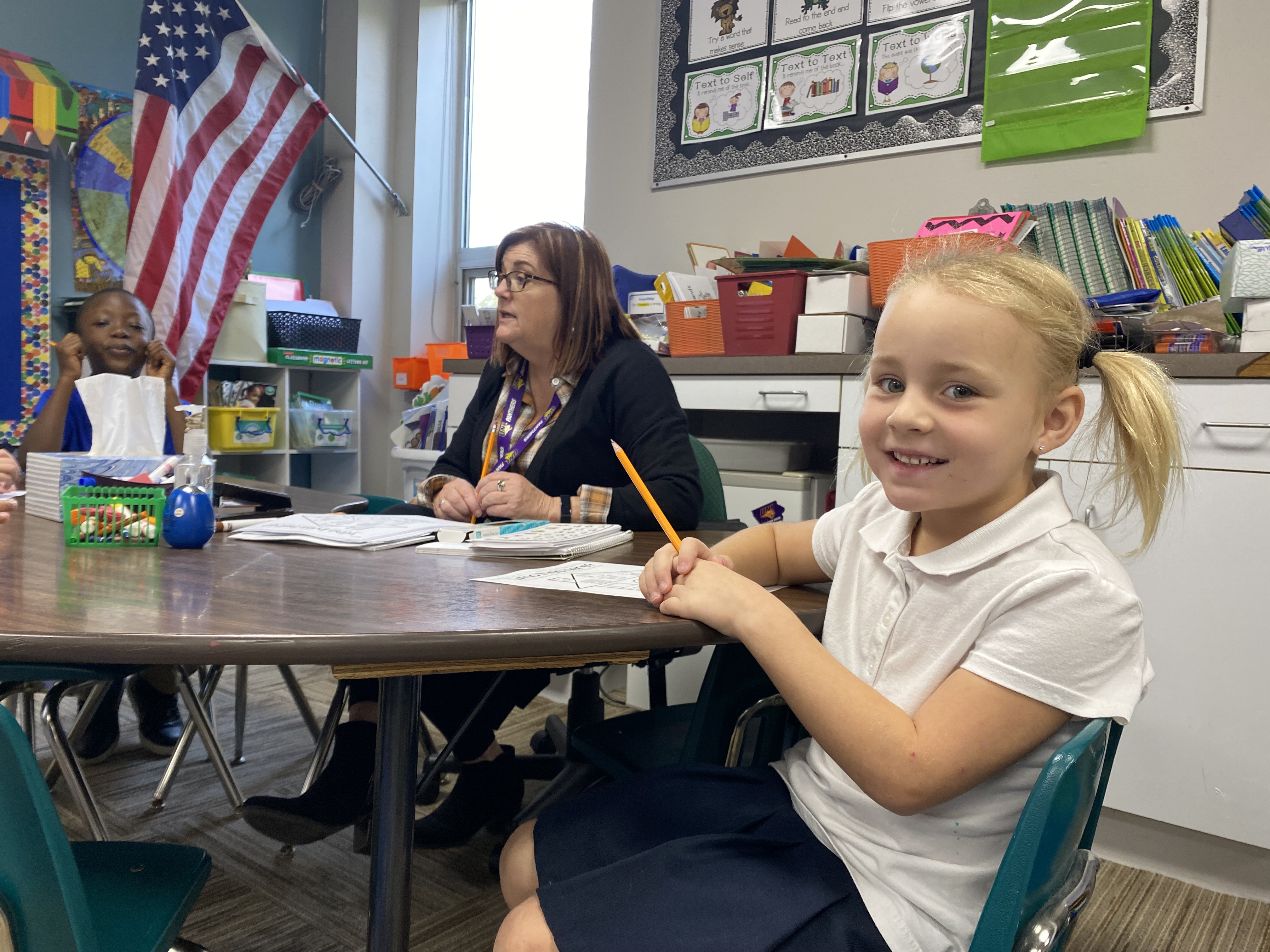Discover the Difference: Catholic Schools Buck National Trend
by Diocese of Des Moines | November 29, 2022

It's no secret that the COVID-19 pandemic disrupted learning across the globe. However, recent news about how much learning U.S. students missed during the last two years has re-ignited a national conversation about the devastating effects of the pandemic on student outcomes.
Data from the National Assessment of Educational Progress tests showed a dramatic shift in student performance following the onset of COVID-19 and school closures – essentially undoing two decades of progress in math and reading (Mervosh, 2022). Math scores dropped in nearly every state, with only 26% of eighth graders demonstrating grade-level proficiency. Fourth graders performed only slightly better, with 36% demonstrating proficiency. Furthermore, in reading, only one in three students demonstrated proficiency, "continuing a downward trend that had begun even before the pandemic," (NYT, 2022).
performance following the onset of COVID-19 and school closures – essentially undoing two decades of progress in math and reading (Mervosh, 2022). Math scores dropped in nearly every state, with only 26% of eighth graders demonstrating grade-level proficiency. Fourth graders performed only slightly better, with 36% demonstrating proficiency. Furthermore, in reading, only one in three students demonstrated proficiency, "continuing a downward trend that had begun even before the pandemic," (NYT, 2022).
However, on average, NAEP scores for eighth-grade Catholic school students were 15 points higher than their public school peers (CAPE, 2022). In addition, Catholic schools further closed the academic achievement gap among minority students throughout the pandemic. According to the Wall Street Journal, "Achievement among Black students enrolled in Catholic schools increased by 10 points (about an extra year's worth of learning), while Black students in public schools lost 5 points and Black students in charter schools lost 8 points. Similarly, on the eighth-grade reading test, Hispanic students in Catholic schools gained 7 points while Hispanic students in public schools lost 1 point and Hispanic students in charter schools lost 2 points," (Magee, 2022).
2022 National Assessment of Educational Progress (NAEP)
|
|
National Public School Average
(Student Score)
|
National Catholic School Average
(Student Score)
|
|
4thReading
|
216
|
233
|
|
4thMath
|
235
|
246
|
|
8th Reading
|
259
|
278
|
|
8th Math
|
273
|
288
|
How Do Diocese of Des Moines Students Stack Up?
The Diocese of Des Moines' efforts to reduce learning loss have paid tremendous dividends based on recent data. Although not an apples-to-apples comparison to the NAEP, the Diocese of Des Moines Catholic schools and Iowa public schools participate in the Iowa Statewide Assessment of Student Progress. ISASP is a standards-based assessment designed to inform schools and families on how students perform on the Iowa Core Academic Standards. Students performing at the proficient level demonstrate adequate competency in the knowledge, skills and abilities that meet the requirements for their grade level associated with academic readiness for college and a career in the subject area.
2022 Iowa Statewide Assessment of Student Progress (ISASP)
|
|
State of Iowa
(Percent Proficient)
|
Diocese of Des Moines
(Percent Proficient)
|
|
5thEnglish Language Arts
|
67%
|
85%
|
|
5thMath
|
65%
|
75%
|
|
5thScience
|
61%
|
76%
|
|
8th English Language Arts
|
76%
|
93%
|
|
8th Math
|
67%
|
82%
|
|
8th Science
|
67%
|
85%
|
|
11th English Language Arts
|
70%
|
77%
|
|
11th Math
|
60%
|
75%
|
*Calculated using a weighted average to account for school enrollment and achievement differences.
During the 2020-2021 school year, the Diocese of Des Moines Catholic schools enacted a diocesan-wide assessment framework. Every elementary school implemented the FASTBridge assessment, and every middle school implemented the Measures of Academic Progress assessment. These assessments allowed teachers to understand student progress and needs better. This additional layer of data allowed teachers to focus on essential skills and better track student growth in these areas. Screening students in the fall, winter and spring created a systematic process to identify students who are struggling earlier and intervene on their behalf.
2021-2022 Diocese of Des Moines FASTBridge Assessment Scores
|
|
On Track or Advanced**
|
Aggressive Growth*
|
|
K-1 Reading
|
63% (Early Reading Skills)
|
16%(Early Reading Skills)
|
|
K-1 Math
|
80% (Early Math Skills)
|
18%(Early Math Skills)
|
|
2-5 Reading
|
76.4% (Fluency)
23% of those scored at the advanced level
76.1% (Comprehension)
21% of those scored at the advanced level
|
31% (Fluency)
19% (Comprehension)
|
|
2-5 Math
|
74% (Fact Fluency)
39% of those scored at the advanced level
|
25% (Fact Fluency)
|
*Aggressive growth is a score increase from fall to spring greater than 75% or more of their peers nationally.
**FASTBridge earlyMath and earlyReading assessments do not assign an "advanced" designation for grades K-1.
The NWEA MAP Assessment showed that Diocese of Des Moines eighth-graders scored as well as or better than 73% of their peers nationwide in math, as well or better than 73% of their peers nationwide in reading, and as well or better than 84% of their peers nationwide in language.
These outcomes indicate that Diocese of Des Moines Catholic school students are bucking the national trend of academic decline. 
Educator Empowerment
While data can help drive student interventions and support, academic growth results from dedicated teachers. Educators across the diocese increased collaboration and data literacy to support student achievement. Developing a robust student support system ensures that every child learns at high levels. In many Diocese of Des Moines Catholic Schools, What I Need or WIN time provides this additional support. WIN time offers flexible time during the school day where teachers can provide small group instruction based on individual student needs. Students who have already demonstrated mastery are provided additional challenges during this time to further their learning.
"Teacher passion and dedication is critical to the continued success of our students," said Dr. Anne Franklin, director of Professional Development. "Our teachers willingly jumped in with both feet."
Teaching the Whole Child
Teaching in a faith-based environment allows educators to know the whole child better. Our teachers can look at every student as a child of God, celebrate the unique gifts they bring to the world, and focus on the totality of the child's developmental needs. Whole child classrooms create "a sense of community and encourage interpersonal skills, problem-solving, goal setting, creativity, autonomy, and self-accountability," (GoGuardian, 2019). While academic success is important, our teachers know that the student's progress in God's plan for them carries far more weight than any academic score. In turn, when students feel valued as more than test scores and academic progress, they thrive, allowing them to reach their fullest potential.
Home-School Partnership
Parents are the first educators of their children. The partnership between home and school helps create open communication and ensures we support the whole child. Throughout the pandemic, teachers provided parents with evidence of individual student growth and outlined how parents can support student learning at home.
"Because our schools are communities of faith, we are blessed to be able to know our students and families on a more personal level," shared Franklin. "Our relationships with our families help us keep open lines of communication and truly partner with parents in their child's education."
Learning Options
The Diocese of Des Moines never lost sight of the value of face-to-face instruction and acknowledged parents' desire to have students return to school. Throughout the 2020-2021 school year, 100% of Diocese of Des Moines Catholic schools were open for in-person instruction with enhanced cleaning and safety protocols to protect students, faculty and staff. Nationally, only 59.8% of public schools were open for in-person instruction (U.S. Department of Education, 2021). Additionally, all 16 schools offered a remote learning option. Regardless of where students attended class, the Diocese of Des Moines and its schools provided an excellent education with reopening plans focused on the whole child and individual family needs.
"We were determined to ensure that learning continued throughout the pandemic," said Donna Bishop, superintendent of Schools. "None of our students missed out on a high-quality education because of this virus. These outcomes are a testament to the commitment of our administrators, faculty, staff, students and parents during this unprecedented time."
The Diocese of Des Moines Catholic Schools includes 16 schools that serve more than 6,300 students across central and southwest Iowa. Catholic schools in the Des Moines Diocese build Christ-centered, collaborative, inclusive partnerships with parents, students, and parishes to provide students with innovative academic excellence and inspirational faith formation. To learn more about Catholic schools in the Diocese of Des Moines, visit www.dmdiocese.org/catholic-schools or email grow@dmdiocese.org.
Sources:
CAPE Outlook. (2022, October). The Nation's Report Card: Catholic Schools a Bright Spot Amidst Dismal News. Edition #478. Retrieved November 2, 2022 from https://capenetwork.org
Clarke, K. (2022, October 25). Catholic schools outperform public and charter counterparts in first post-Covid national assessment. Retrieved November 2, 2022 from https://www.americamagazine.org/politics-society/2022/10/25/catholic-schools-naep-244026.
GoGuardian. (2019). Retrieved November 10, 2022 from https://www.goguardian.com/blog/what-is-whole-child-learning-and-why-is-it-important.
Learning Policy Institute. (2022). Whole Child Education. Retrieved November 1, 2022 from https://learningpolicyinstitute.org/topic/whole-child-education.
Mervosh, S. (2022, September 1). The Pandemic Erased Two Decades of Progress in Math and Reading. Retrieved October 15, 2022 from https://www.nytimes.com/2022/09/01/us/national-test-scores-math-reading-pandemic.html.
Porter-Magee, K. (2022, October 27). Amid the Pandemic, Progress in Catholic Schools: Enrollment and student achievement are rising, thanks in part to parents. Retrieved October 31, 2022 from https://www.wsj.com/articles/amid-the-pandemic-progress-in-catholic-schools-partnership-naep-report-card-math-reading-public-charter-black-hispanic-11666902117
Southern Oregon University. (2020). What is the ‘Whole Child’ Approach to Learning? Retrieved November 1, 2022 from https://online.sou.edu/degrees/education/msed/leadership-in-higher-education/whole-child-approach-learning/.
Stoll, I. (2022). Catholic Schools Are a Rare Bright Spot in Nation’s Report Card 2022 Data. Retrieved November 1, 2022 from https://www.educationnext.org/catholic-schools-are-a-rare-bright-spot-in-nations-report-card-2022-data/.
The New York Times. (October 24, 2022). On a national exam, U.S. students show deep declines in math and a dip in reading, an indictment on the pandemic's effects on learning. Retrieved October 24, 2022 from https://www.nytimes.com/2022/10/24/us/math-reading-scores-pandemic.html?campaign_id=60&emc=edit_na_20221024&instance_id=0&nl=breaking-news&ref=cta®i_id=122024843&segment_id=110894&user_id=18d211b785d0c7c4d4ff2d0cdd9cd19b.
U.S. Department of Education, Institute of Education Sciences, National Center for Education Statistics, National Assessment of Educational Progress (NAEP), Monthly School Survey 2021.